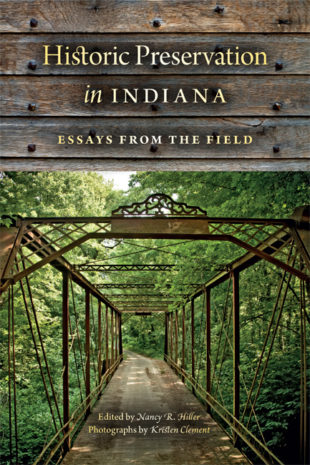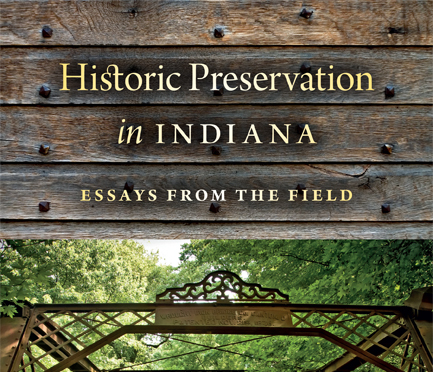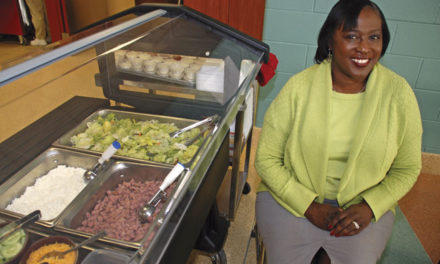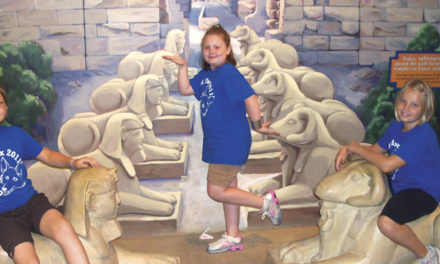
Courtesy photo
BY LEE ANN SANDWEISS
Controversies over historic preservation regularly make the news, in Bloomington and throughout Indiana. A new book of essays from Indiana University Press explores the enduring issues behind those headlines.
“Some people see historic preservation as a threat to their property rights but have no idea about the values behind the enterprise,” says Nancy Hiller, a cabinet maker, writer, and member of the Monroe County Historic Preservation Board of Review, who edited Historic Preservation in Indiana: Essays from the Field. “That’s why I wanted to do this book — to discuss what preservation is really about — our homes and neighborhoods, our history, the buildings and places that contribute so much to our sense of identity.”
The volume brings together 13 essays by Bloomington writers who represent a wide range of perspectives on historic preservation. Yet one basic motivation underlies these diverse approaches. As Duncan Campbell, retired director of Ball State University’s graduate program in historic preservation and member of the board of Indiana Landmarks, points out in the preface, “Each proponent in his or her own way is fighting the same battle — the battle for place.”
That battle looks different according to where and how it’s fought. Starting with financial considerations, philanthropist Gayle Cook explains how preservation can serve as a means of economic revitalization. Indianapolis native and jazz journalist David Brent Johnson writes about rediscovering that city’s rich musical heritage and the places, lost and saved, connected to it. Archaeologist Cheryl Ann Munson demonstrates the value of archeological research to historic preservation, and vice-versa. Author Scott Russell Sanders blends personal and local mythology in his contemplation of the fish that graces the dome of the Monroe County Courthouse. Genealogist Elizabeth Schlemmer’s essay recounts the years-long battle and dramatic 11th-hour action that saved Bloomington’s Carnegie Library (now the Monroe County History Center) from becoming a parking lot.
“Even though the writers are from Bloomington, the essays have broad applicability,” explains Hiller. “It’s very easy to become discouraged if you are fighting to save a building from destruction or to keep a farm intact. I also wanted this book to be strategically helpful and give people ideas of things they could do. It’s critical that these stories of success against all odds be told and retold. It comes down to the fact that we are all part of a community and need to recognize the common good.”












Hello, this is a true story based in Indiana that I would like for your magazine to consider publishing about an excavation of President Lincoln’s former cabinet member, Caleb Blood Smith. I attended this excavation in November, 1977 in Connersville, Indiana’s City Cemetery. The reason this excavation was being done was because Smith’s body has never been found, even though there is a Mausoleum in Indianapolis’s Crown Hill Cemetery (it was opened in 1976, and it was discovered to be empty.)
Smith’s body was originally taken from Greenlawn Cemetery in Indianapolis and moved to Crown Hill by his wife Elizabeth. After the Civil War southern dissenters were coming south to North to descrate bodies. Smith’s wife was terrified of the thought so she had her husbands body moved several times.
In this PDF file that I’d like to send to you has pictures of the excavation, and a consent to open said grave with signatures of the family members. Also included is family stories, letters from NY, and other letters about the location of Smith’s body. It’s 55 pages. My grandfather, John Walker wrote 25 pages and I added about 30. The writer of this is John Walker and his granddaughter, Cynthia Long I hope you will consider publication of this story in you magazine. I’m giving you a link here> Indiana unsolved mystery that you can look at the story and other documentation right away.
Thank you so much for the story idea, Lyn. I’m sorry, but we generally don’t do stories about Indianapolis.
It’s not a story about Indianapolis, it’s a story about an Indiana Civil War mystery in Indiana. Sounds like you didn’t read the entire story. (but just a few lines at the beginning) I have read that story, and it’s very good.